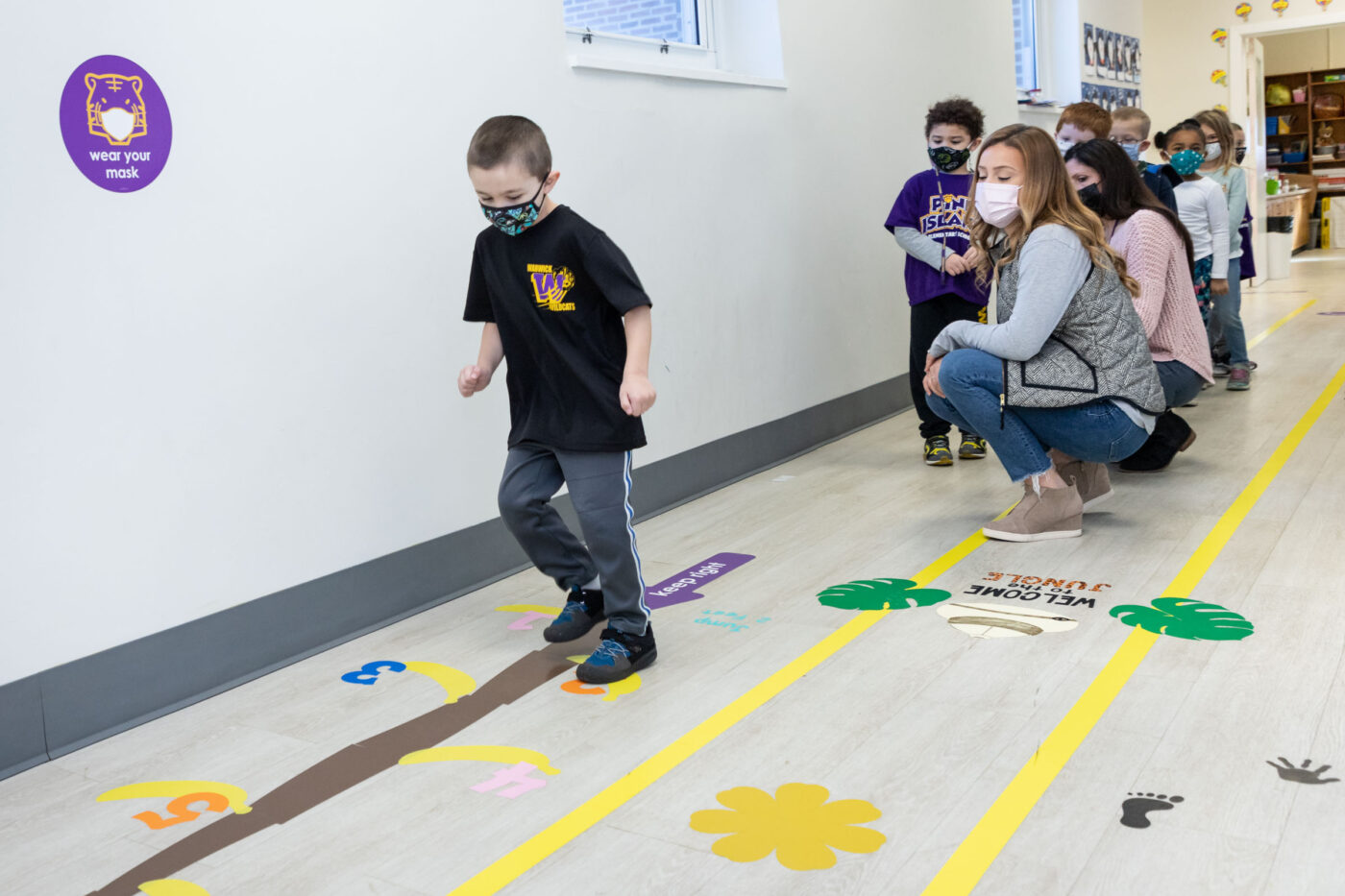Sensory paths added at Pine Island Elementary School
Warwick Valley Central School District occupational therapists recently designed, created and installed two sensory pathways for kindergarten students at Pine Island Elementary School.
The pathways are made of vinyl stickers of numbers, letters and images on the floor that students follow while doing activities like hopping, crawling and stomping.
“It’s been a very, very popular and worthwhile activity, especially at this level where kids are just beginning to use certain movements and spatial awareness,” said Pine Island principal John Russo, who has a background in physical education. “I think it’s great.”
The occupational therapists (Kristen Longo, Ashley Ludington and Heather Hilliard) came up with designs and used a Cricut machine to print out vinyl stickers. Then the therapist just had to peel off the stickers and place them on the floor. There are two different sensory paths, one on the first floor and one on the second floor.
“The district had reached out to us asking if we would be creative and come up with a way to put something together,” Ms. Longo said. “We came up with all the different designs and the different ideas of what sensory movements we wanted.”

The sensory path activities include jumping from one numbered banana to the next on a banana tree, walking like a gorilla by following handprints and footprints and tiptoeing on letters of the alphabet arranged in a figure eight.
“It helps the kids with their motor planning, their balance, their vestibular system, and also their visual system just by being able to follow along,” Ms. Longo said. “Because you’re using your senses with the learning, it helps your body and brain to take it in better.”
The occupational therapists sometimes take students to use the sensory paths. And the occupational therapists also made a video of how to do each activity so teachers could bring their classes to the paths.
“A lot of times when the teachers see that the kids need to get up and move a little bit, they’ll come out and use it kind of as a brain break.” Ms. Longo said. “It helps the students to come back and be more focused and be calmer, and that way it’s easier for them to stay on task when they are in the classroom.”
Pine Island Elementary School teachers Katherine Caswell and Lorie Ingber are very excited (and very grateful to the OT department) that their students now have two sensory paths to use.
“The students love using the sensory paths,” Mrs. Caswell said. “They will often ask to go out and use it when it is time for a brain break. Everyone has a favorite part of the path. However, ‘the bridge’ and the ‘banana counting tree’ seem to be the most popular. Mrs. Ingber, my co-teacher, likes that the path gives the children a chance to practice foundational skills using a multi-sensory approach.”
Warwick Valley Central School District occupational therapists recently designed, created and installed two sensory pathways for kindergarten students at Pine Island Elementary School.
The pathways are made of vinyl stickers of numbers, letters and images on the floor that students follow while doing activities like hopping, crawling and stomping.
“It’s been a very, very popular and worthwhile activity, especially at this level where kids are just beginning to use certain movements and spatial awareness,” said Pine Island principal John Russo, who has a background in physical education. “I think it’s great.”
The occupational therapists (Kristen Longo, Ashley Ludington and Heather Hilliard) came up with designs and used a Cricut machine to print out vinyl stickers. Then the therapist just had to peel off the stickers and place them on the floor. There are two different sensory paths, one on the first floor and one on the second floor.
“The district had reached out to us asking if we would be creative and come up with a way to put something together,” Ms. Longo said. “We came up with all the different designs and the different ideas of what sensory movements we wanted.”
The sensory path activities include jumping from one numbered banana to the next on a banana tree, walking like a gorilla by following handprints and footprints and tiptoeing on letters of the alphabet arranged in a figure eight.
“It helps the kids with their motor planning, their balance, their vestibular system, and also their visual system just by being able to follow along,” Ms. Longo said. “Because you’re using your senses with the learning, it helps your body and brain to take it in better.”
The occupational therapists sometimes take students to use the sensory paths. And the occupational therapists also made a video of how to do each activity so teachers could bring their classes to the paths.
“A lot of times when the teachers see that the kids need to get up and move a little bit, they’ll come out and use it kind of as a brain break.” Ms. Longo said. “It helps the students to come back and be more focused and be calmer, and that way it’s easier for them to stay on task when they are in the classroom.”
Pine Island Elementary School teachers Katherine Caswell and Lorie Ingber are very excited (and very grateful to the OT department) that their students now have two sensory paths to use.
“The students love using the sensory paths,” Mrs. Caswell said. “They will often ask to go out and use it when it is time for a brain break. Everyone has a favorite part of the path. However, ‘the bridge’ and the ‘banana counting tree’ seem to be the most popular. Mrs. Ingber, my co-teacher, likes that the path gives the children a chance to practice foundational skills using a multi-sensory approach.”





